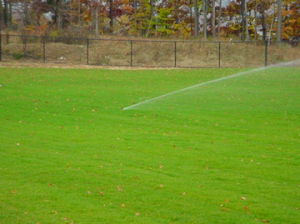Turf Installation Guide
Sodding your lawn allows you to enjoy instant beauty and maturity, without the usual time consuming hassles of seeding.
The following are the basic steps to a beautiful lawn.
STEP 1 – Measuring and Ordering

With a tape, measure the area of your planned lawn. Note these measurements on a sketch of the lawn area, including any unusual features. Sod is sold by square foot. Pieces are 10 square foot – 2 feet wide and 5 feet long.
Schedule your sod delivery after the preparatory work is completed and you are ready to install. Prompt installation on the day of delivery is crucial to a strong beginning for your lawn.
STEP 2 – Soil Preparation

For best results, rototill or spade the area to a depth of 4 to 6 inches. Eliminate any drainage problems by sloping the soil away from foundations.
Soil test your lawn area with the assistance of a qualified service. Rake in fertilizer, lime, peat, compost, etc., as needed to a depth of 3 to 4 inches.
Rake and smooth the soil, removing rocks, roots, and large clods. Lightly roll the area with a lawn roller, 1/3 full of water. This will firm the soil surface and reveal any low areas that need more soil. Keep the grade 1 inch below sidewalks or driveway.
Water the prepared area to settle soil and provide a moist base for turf. A depth of 6 inches is recommended for most soils.
STEP 3 – Turf Installation

Install your lawn immediately after delivery. Begin watering lawn within 30 minutes of installation. Sod is a living plant that requires ground contact and moisture in order to survive.
In hot weather, protect unlaid sod by placing stacks in shade, covering with moist burlap, and/ or sprinkling.
Begin installing sod along the longest straight line, such as a driveway or sidewalk. Butt and push edges and ends against each other tightly, without stretching. Avoid gaps or overlaps. Stagger the joints in each row in a brick-like fashion, using a large, sharp knife to trim corners, etc. Avoid leaving small strips at the outer edges, as they will not retain moisture. On a slope, place the sod horizontally across the slope.
Avoid repeated walking or kneeling on sod while it is being installed or just after watering, which causes indentations and/or air pockets.
STEP 4 – Watering

Give your new lawn at least 1 inch of water within ½ hour of installation. Water daily, around noontime, keeping sod moist until it is firmly rooted (about 3 weeks). If sod is watered sufficiently the root structure and the soil underneath should be saturated. Afterwards, less frequent and deeper watering should begin.
Weather conditions with dictate the amount and frequency of watering. Be certain that your new lawn has enough moisture to survive hot, dry or windy periods.
Water areas near buildings more often, where reflected heat dries the turf.
Caution

During the first three weeks, avoid heavy or concentrated use of your new lawn. This will give the roots an opportunity to firmly knit with the soil, and insure that the turf will remain smooth.
Maintenance
Maintain new sod and existing lawn the same.
Do not mow for 3 weeks or until the sod is firmly rooted. The first cut should be done with the mower blades on the highest setting, generally remove no more than 1/3 of the grass height at a mowing. Keep the mower blades sharp
Fertilizer and chemical applications will depend on climate, sod type, soil, insects, weed and disease conditions.
